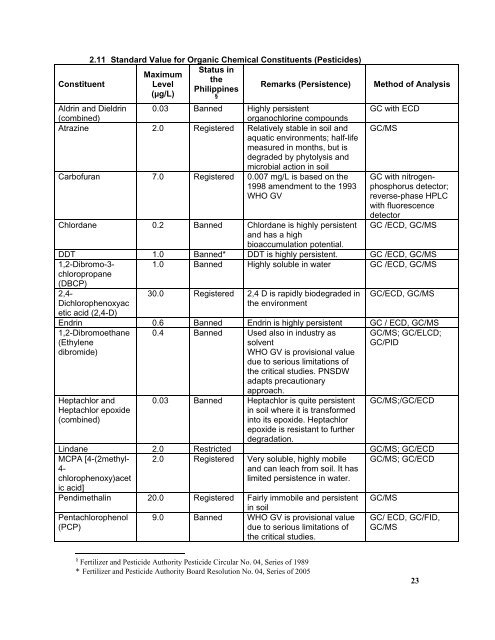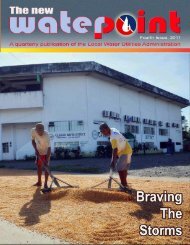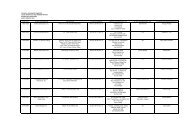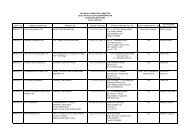Philippine National Standards for Drinking Water - LWUA
Philippine National Standards for Drinking Water - LWUA
Philippine National Standards for Drinking Water - LWUA
Create successful ePaper yourself
Turn your PDF publications into a flip-book with our unique Google optimized e-Paper software.
2.11 Standard Value <strong>for</strong> Organic Chemical Constituents (Pesticides)<br />
Status in<br />
Maximum<br />
the<br />
Constituent<br />
Level<br />
Remarks (Persistence)<br />
<strong>Philippine</strong>s<br />
(µg/L)<br />
§<br />
Aldrin and Dieldrin<br />
(combined)<br />
0.03 Banned Highly persistent<br />
organochlorine compounds<br />
Atrazine 2.0 Registered Relatively stable in soil and<br />
aquatic environments; half-life<br />
measured in months, but is<br />
degraded by phytolysis and<br />
microbial action in soil<br />
Carbofuran 7.0 Registered 0.007 mg/L is based on the<br />
1998 amendment to the 1993<br />
WHO GV<br />
Chlordane 0.2 Banned Chlordane is highly persistent<br />
and has a high<br />
bioaccumulation potential.<br />
Method of Analysis<br />
GC with ECD<br />
GC/MS<br />
GC with nitrogenphosphorus<br />
detector;<br />
reverse-phase HPLC<br />
with fluorescence<br />
detector<br />
GC /ECD, GC/MS<br />
DDT 1.0 Banned* DDT is highly persistent. GC /ECD, GC/MS<br />
1,2-Dibromo-3-<br />
chloropropane<br />
(DBCP)<br />
1.0 Banned Highly soluble in water GC /ECD, GC/MS<br />
2,4-<br />
Dichlorophenoxyac<br />
etic acid (2,4-D)<br />
30.0 Registered 2,4 D is rapidly biodegraded in<br />
the environment<br />
GC/ECD, GC/MS<br />
Endrin 0.6 Banned Endrin is highly persistent GC / ECD, GC/MS<br />
1,2-Dibromoethane<br />
(Ethylene<br />
dibromide)<br />
GC/MS; GC/ELCD;<br />
GC/PID<br />
Heptachlor and<br />
Heptachlor epoxide<br />
(combined)<br />
0.4 Banned Used also in industry as<br />
solvent<br />
WHO GV is provisional value<br />
due to serious limitations of<br />
the critical studies. PNSDW<br />
adapts precautionary<br />
approach.<br />
0.03 Banned Heptachlor is quite persistent<br />
in soil where it is trans<strong>for</strong>med<br />
into its epoxide. Heptachlor<br />
epoxide is resistant to further<br />
degradation.<br />
GC/MS;/GC/ECD<br />
Lindane 2.0 Restricted GC/MS; GC/ECD<br />
MCPA [4-(2methyl-<br />
4-<br />
chlorophenoxy)acet<br />
ic acid]<br />
2.0 Registered Very soluble, highly mobile<br />
and can leach from soil. It has<br />
limited persistence in water.<br />
GC/MS; GC/ECD<br />
Pendimethalin 20.0 Registered Fairly immobile and persistent<br />
in soil<br />
Pentachlorophenol<br />
(PCP)<br />
9.0 Banned WHO GV is provisional value<br />
due to serious limitations of<br />
the critical studies.<br />
GC/MS<br />
GC/ ECD, GC/FID,<br />
GC/MS<br />
§ Fertilizer and Pesticide Authority Pesticide Circular No. 04, Series of 1989<br />
* Fertilizer and Pesticide Authority Board Resolution No. 04, Series of 2005<br />
23







